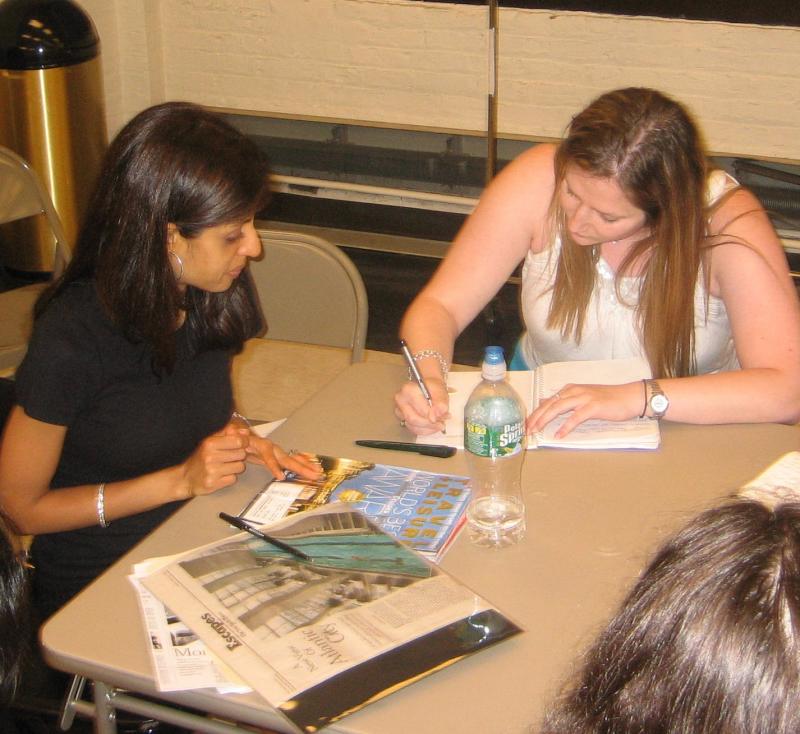While still a student at NYU’s journalism school, Shivani Vora published a cover story in the Food section of the New York Times. Vora has since written for Forbes.com, the Wall Street Journal, Page Six magazine, and other sections of the Times. A couple months ago, she sat down with eager Edsters and shared her top ten recession-proof tips about freelancing for a new, one-night-only EdSchool class.
10) Layoffs Can Actually Benefit Freelancers
The economy has presented freelancers with a unique predicament: most budgets are cutting freelancers, but with rounds and rounds of layoffs, editors need freelancers to provide content more than ever.
9) Use Your Own Life as Inspiration
One day, Vora wanted to exercise but it was too hot. She realized she’s not the only one suffering from the New York heat wave, so she brainstormed unique summer workout tips and (voila!) got a new trend piece to pitch.
8) Read Everything to Inspire Ideas
Everything from the Whole Foods newsletter to press releases found on prnewswire.com can lead to an interesting pitch. (Be sure to check off your areas of interest as reading every press release out there could become overwhelming.)
7) Network at Every Informational Interview
Vora has a personal 5/5 networking tip that works like this: ask to meet an editor for an informational interview. Make the most of the editor’s (short) time by researching their publication and pitching 5 ideas during your coffee date. You will not only impress them, but you might even get a story assigned then and there. Before you leave, ask for 5 names and emails of other editors in the industry.
Fun fact: Vora’s 5/5 networking tip is how she got her cover story published in the Times Food section—even as professors and colleagues were telling her she didn’t have a chance. She got the name of the Times’ Dining Editor and when she came in to meet for ten minutes, she pitched three ideas, two of which were accepted.
6) Pitch First, Write Later
Writing the whole article before anyone accepts it is not a good use of your time, Vora says. But you do have to research your pitch. Include statistics where relevant to back up trends and Google industry associations or look through Amazon’s book search for relevant experts to quote about the topic. Double-check that a similar story has not already been published, either in the magazine you’re pitching or a competing one.
5) Start by Pitching Smaller Stories to FOB Sections
FOB sections of magazines are easier to break into, whereas newspapers and websites are more open to bigger stories from new writers. In your pitch, include which section of the magazine or paper you envision your story running in.
4) Always Follow-Up Unless You Are Told Otherwise
“The writers with the most bylines are not the most talented necessarily; they’re just the most persistent,” Vora says. She advises emailing a newspaper or online editor every week and a magazine editor every two weeks until you hear a response. “Do not assume they’re not interested,” Vora adds. Expert tip: try to avoid pitching editors before their deadline. They will be a lot less likely to even look at your email then.
3) Consider Writing For Free
If you’re a new writer, writing on spec (where you are assigned a story with no guarantee for publication) or writing for free at first might be a good investment. “Clips are your currency,” Vora says, “No one ever asks for my resume when I pitch.” She began writing for small papers like the News Indian Times, where she got great clips and interviewed famous celebrities like Mira Nair and Jhumpa Lahiri.
2) Diversify the Outlets You Write For
Don’t get too comfortable with one publication. Vora wrote regularly for Page Six magazine before it folded and she found her monthly income reduced. The more publications you write for, the less likely you will go broke if one of them folds.
1) Organize Everything in Spreadsheets
Vora suggests you keep two spreadsheets. One should be for Ideas which includes: possible markets, status, where you found the market, and additional notes. The second should be for Payment Records which includes: story, publication, due date, to be published date, fee, and when the payment was received.




 Yelena Shuster
Yelena Shuster